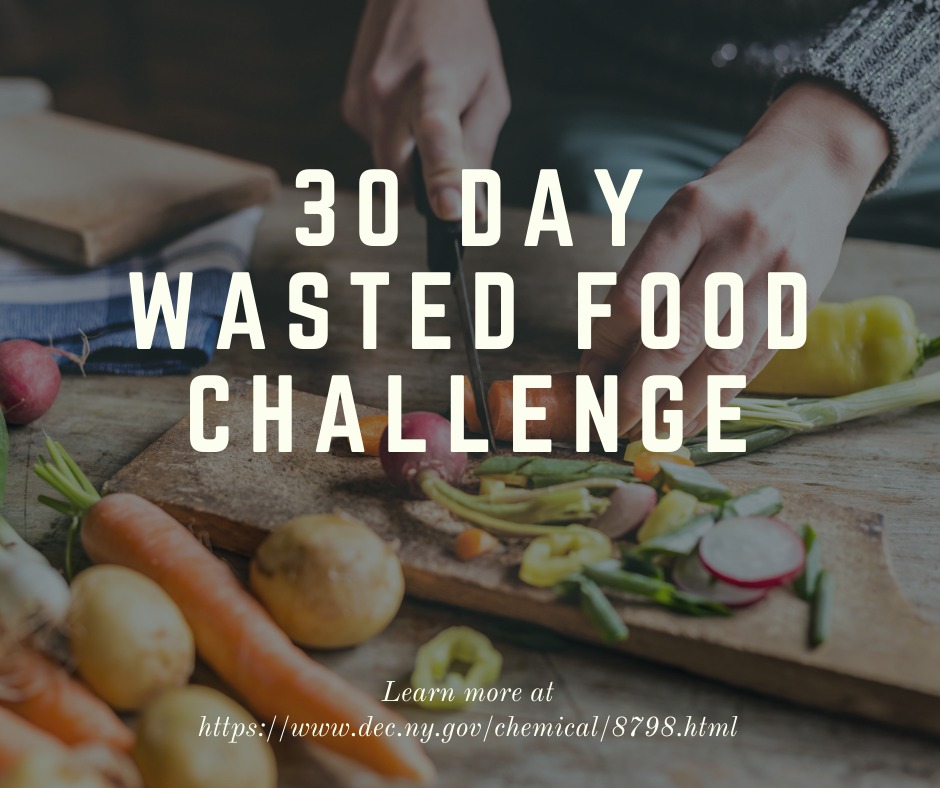Wasting Less Food in Just 30 Days
Take the NYS DEC 30 Day Wasted Food Challenge

We look at January 1st as a new chapter, a time to start fresh. However, if you find the idea of drafting up a new list of New Year’s resolutions a bit too abstract, our 30-day wasted food challenge might be a fit, focusing on doing small tasks each day in order to build habits that will stick.
Forty percent of all food produced in the US goes uneaten. Wasted food is a major contributor to multiple environmental and social problems that we face today – and most of this waste is happening right under our noses! ReFED estimates US households alone waste 76 billion pounds of food annually, costing each household an average of $1,800 per year!
Throughout January, we’ll be leading you through a 30-day wasted food challenge. You can accomplish this challenge in a number of ways, and by the end, we will help you throw away less food in your kitchen, save money, and benefit our environment.
- Week 1: Recognize what food you’re already throwing away
- Week 2: Develop a plan
- Week 3: Take action
- Week 4: Reflect
Week 1: Recognize What Food You’re Already Throwing Away
Spend the first few days of your challenge jotting down all of the food you throw away – uneaten leftovers, scraps from dinner, food that’s gone bad, etc. This will help you gain a sense of what, why, and how food is getting wasted through the course of your normal day.
Pro tip: Take photos and share! Public accountability can help you stick to your goals. You’ll probably even gain a few supporters along the way, rooting you on!
Week 2: Develop a Plan
Now that you know where your waste is coming from, you can research ways to avoid it! Spend time getting familiar with ways to avoid wasting food.
Some examples:
- Start meal planning for the week ahead. Paired with a shopping list, this can help reduce overbuying at the grocery store and take the guess work out of each night’s food choices.
- Look up creative ways to store and display your leftovers, and incorporate an “Eat This First” container or area so you can prioritize items before they go bad.
- Watch this video to learn about meal planning, storage, and prep tips with Tompkins County.
- Expand your recipe collection with recipes that incorporate commonly wasted foods such as peels, roots, trimmings, and bones.
- Practice preserving food via freezing, jarring, or pickling.
- Learn the difference between “sell by,” “use by,” “best by,” and expiration dates.
Week 3: Take Action
Use your new-found knowledge and apply these techniques to real life. For the next two weeks, work hard on implementing the strategies you’ve learned to minimize the amount of food you throw out. Pack up those leftovers, designate a day for meal prep, and figure out your perfect serving size. The world is your oyster!
“Oh no, I messed up!”
Don’t panic! We’re aiming for progress, not perfection. Learn from any mishaps, and pick the momentum back up at your next meal!
Week 4: Reflect
Look at what you’ve managed to accomplish across this past month with a little planning and a fresh perspective! You can now assess the lessons you’ve learned and use them to help you implement new habits and waste reduction techniques to waste less food.
Share with others. Now that you’ve successfully chomped through this 30-day challenge, share your journey with the world. You can help others! Post tips and tricks, favorite recipes, or things that may have surprised you along the way to encourage friends and family to join the challenge themselves!
Let us know how you’re doing at organicrecycling@dec.ny.gov.
